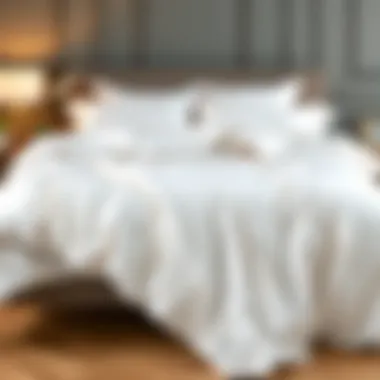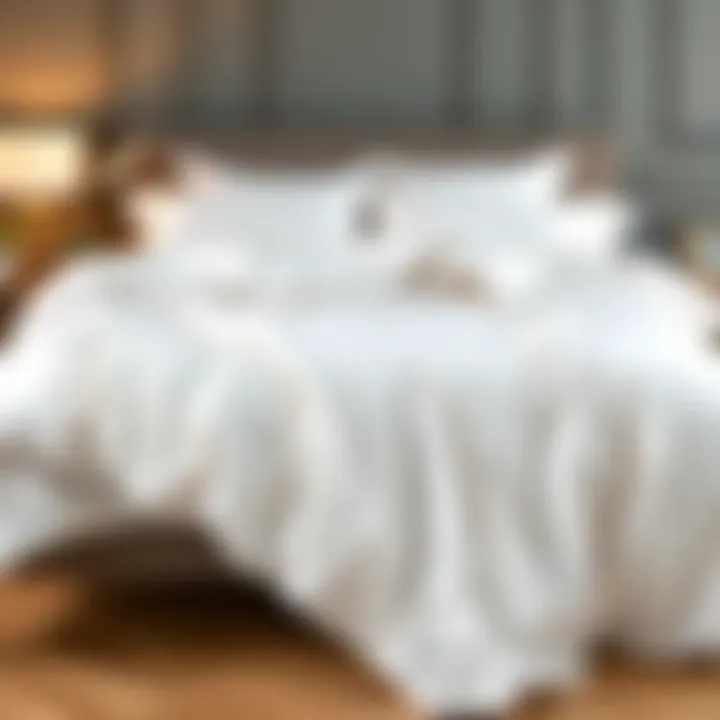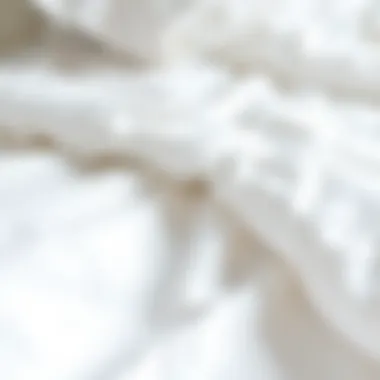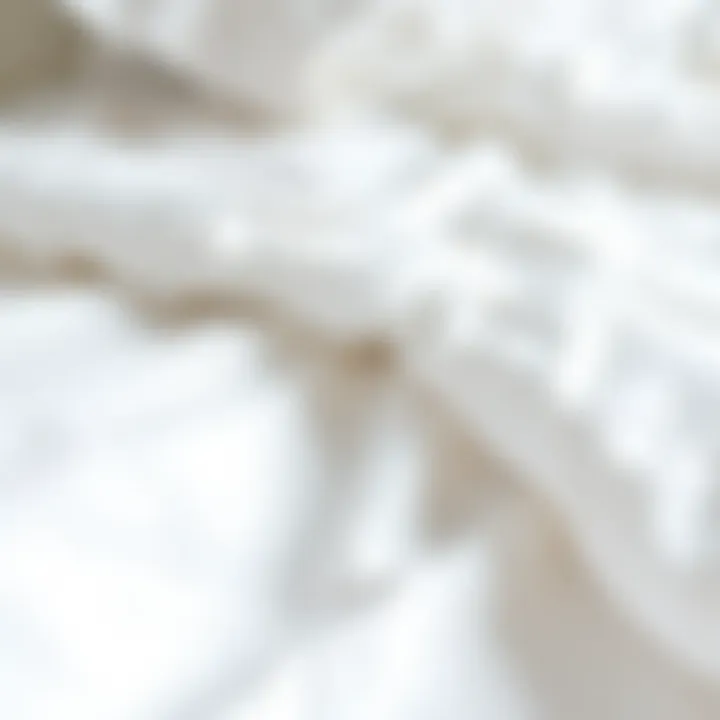The Importance of Quality White Duvet Covers


Intro
When wandering through the lush landscape of interior design, one quickly realizes that the little details matter just as much as the grand statement pieces. White duvet covers, for instance, might seem simple at first glance, yet their quality can greatly influence the overall aesthetic of a space. Choosing a premium white duvet cover is not merely a preference, but a strategic decision that enhances the feel and style of any room.
Not only do these duvet covers serve a practical purpose, but they are also pivotal in creating a serene and cohesive look. Their versatility allows them to seamlessly fit into a variety of decor styles, from minimalist chic to cozy cottage. In this exploration, we will delve into what makes a duvet cover stand out in terms of quality, the types of materials available, and essential maintenance tips that ensure your investment stands the test of time.
In the world of design, as they say, "the devil is in the details." \nLet’s take a closer look at how these thoughtful choices can speak volumes in a curated living environment.
Furniture Design Insights
Understanding Style Preferences
When it comes to selecting a white duvet cover, it is essential to consider the overall style of your space. Think about the characteristics that define your design choices. Are you drawn to contemporary lines and soft textures or rustic warmth accented by vintage pieces? The duvet cover can act as a blank canvas, setting the tone for other elements while offering comfort and functionality.
- Minimalist Approach: If simplicity is your goal, opt for a crisp, white, high-thread-count cotton duvet cover. This choice can create a fresh and airy atmosphere.
- Eclectic Vibes: For an eclectic design, consider a duvet cover that has subtle patterns or textures, making a statement without overwhelming the overall look.
- Modern Luxury: For a more opulent feel, you might gravitate towards fabrics like linen or sateen. Their luxurious touch can add an indulgent layer to your bedding choices.
Maximizing Space with Smart Layouts
A well-chosen duvet cover does more than just beautify a bed; it can also influence your perception of space. Light colors, especially white, tend to open up rooms, creating a sense of spaciousness that darker tones might inhibit. Consider the following:
- Layering Textures: Mixing different textures, like a smooth duvet cover with a knitted throw, can bring depth without cluttering the space.
- Color Coordination: Pairing a white duvet cover with accent pillows in soft pastels works harmoniously to establish a tranquil environment.
- Functionality Meets Aesthetics: Choosing duvet covers that are easy to remove and wash can also contribute to a chic yet practical bedroom layout.
"Design is not just what it looks like and feels like. Design is how it works." – Steve Jobs
Maintenance and Care Tips
Cleaning Techniques for Different Materials
Different materials require varied care, ensuring that your white duvet cover maintains its elegance over time. For cotton, a gentle cycle in cold water works wonders.
- Linen Covers: These beautiful whites often soften with age but need air drying. Avoid high heat to prevent shrinkage.
- Sateen Finish: Use mild detergent and stay away from harsh chemicals to retain the fabric's sheen.
Preventative Measures Against Wear and Tear
To ensure longevity, it is crucial to employ a few preventative measures. Here are some practical tips:
- Use a Duvet Cover Protector: This additional layer can help shield against spills and stains.
- Regular Rotation: Change your duvet cover regularly to reduce wear on one specific cover and extend its lifespan.
- Smart Storage: When not in use, store your duvet covers in a dry, cool place to prevent mildew.
Understanding Duvet Cover Quality
When it comes to setting the stage for your bedroom's ambiance, few elements play as pivotal a role as a duvet cover. With just the right choice, you can elevate the entire look of your space, create a welcoming retreat, and enhance your comfort. Understanding the essence of duvet cover quality is fundamentally intertwined with appreciating how it impacts both functionality and aesthetic appeal.
Defining Quality in Bedding
Quality in bedding might come across as a vague term, but in practical terms, it breaks down into specific traits that matter. Not all duvet covers are fashioned the same, and the nuances can certainly sway your overall experience. Think about the tactile sensations, durability, and design cohesion with the bedroom theme. A quality duvet cover is not just a pretty face—it should withstand wear and tear while maintaining its aesthetic charm over time.
Here are some key aspects to consider in defining quality:
- Material: The fabric significantly impacts how the duvet feels and performs.
- Construction: Look for reinforced seams and quality stitching for longevity.
- Design and Style: A cover that resonates with your personal style enhances your peace of mind.
Key Indicators of a Good Quality Duvet Cover
When assessing whether a duvet cover is worth your investment, consider specific indicators that reflect its quality. Not all covers will tick the boxes, and some may offer a fleeting charm that fades faster than you'd like. So, list these qualities as a checklist when shopping around:
- Fabric Type: Natural fibers such as cotton or linen tend to breathe better compared to synthetic alternatives.
- Thread Count: Higher thread counts often result in a softer feel; though it's not the only factor determining comfort.
- Fit: Ensure that the cover corresponds accurately with your duvet size, preventing annoying bunching or bulging.
- Washing Instructions: A cover that's easy to care for can make all the difference in maintaining its fresh appearance.
A good quality duvet cover ensures that your bedding remains inviting and fresh night after night. By zeroing in on these indicators, you’ll not only make an informed purchase, but you’ll also set the foundation for cozy evenings and refreshing mornings.
“Investing in a high-quality duvet cover is more than a design choice; it creates a sanctuary that mirrors your personality.”
In summary, understanding duvet cover quality lays the groundwork for wise selections. A thoughtful approach can lead you down a path where your bedding is both a visual delight and a cozy companion.”


Material Choices for Duvet Covers
Cotton: The Classic Choice
Cotton stands tall as the go-to fabric in the bedding world. This material brings a host of benefits. First off, it’s breathable, which means you won’t wake up drenched in sweat on a steamy summer night. With its natural fibers, cotton allows air circulation, creating a comfortable sleeping environment.
Moreover, cotton duvet covers come in various finishes and thread counts, ranging from percale to sateen. Percale gives a crisp, cool feel, while sateen offers a softer, luxe touch. The versatility in finishes means you can pick a style that suits your sleeping preferences.
"Cotton isn't just fabric; it's a lifestyle choice that speaks comfort."
However, it's worth keeping an eye out for the quality of cotton. Look for options labeled as "Egyptian" or "Pima" as these tend to be the cream of the crop, known for their strength and softness. Nonetheless, be prepared to pull your wallet out a bit further because quality cotton duvet covers may come with a higher price tag.
Linen: The Luxurious Alternative
For those who appreciate a more sophisticated aura in their bedrooms, linen is your new best friend. Renowned for its natural, rustic charm, linen brings a unique texture that not only feels good against the skin but also ages beautifully. The fabric has this marvelous ability to keep you warm during winter and cool when temperatures soar, making it a year-round companion.
Linen, however, does come with its quirks. For one, it's prone to wrinkling, which might not be everyone's cup of tea. But, many see this as a part of its understated elegance, offering a relaxed, breezy vibe that pairs well with a minimalist design. You might find that its slightly higher price reflects its status as the luxury fabric of choice—its durability and comfort are hard to beat.
Microfiber: Affordability and Functionality
If your budget doesn't allow for cotton or linen, microfiber is a solid alternative that’s gaining in popularity. This synthetic fabric is engineered to maximize comfort while keeping costs down. Microfiber is super soft, lightweight, and resistant to wrinkles—ideal for those who dislike ironing!
Additionally, microfiber duvet covers are excellent in resisting stains and are often machine washable. They come in an array of colors and designs, though pure white versions might be a little harder to find if you're aiming for a classic aesthetic.
While some folks may miss the breathability of natural fibers, microfiber has made a name for itself with a loyal following thanks to its functionality and practicality. It’s often preferred for children’s rooms or guest bedrooms, where ease of care is paramount.
In summary, the choice of material for your duvet cover can make or break your sleeping experience. Whether it’s the breathable allure of cotton, the timeless elegance of linen, or the budget-friendly usefulness of microfiber, understanding these materials is key to a restful night's sleep.
Thread Count and Its Relevance
When it comes to selecting the right duvet cover, thread count is often mentioned as a key element. It's not just a marketing ploy; understanding thread count plays a significant role in determining the overall quality and feel of your bedding. In essence, thread count refers to the number of threads woven together in a square inch of fabric. It can have a direct impact on the softness and durability of the duvet cover.
A higher thread count often suggests a denser weave, which can lead to enhanced comfort and a more luxurious feel. However, it’s essential to recognize that not all high thread counts are created equal. This aspect is where several nuances come into play. If you’re not careful, you could end up with a duvet cover that looks opulent but lacks in touch and longevity.
Understanding Thread Count
To grasp thread count more effectively, consider how it's calculated. The total is the sum of both vertical (warp) and horizontal (weft) threads. For example, a 300 thread count fabric consists of 150 warp threads and 150 weft threads. This can contribute to a smoother surface, which in turn can enhance your sleeping experience.
However, keep in mind that an exorbitantly high thread count often comes with diminishing returns. Beyond a certain point, the additional threads contribute less to comfort and more to weight or stiffness. So, critical thinking is needed when diving into the numbers. A count of around 300-500 is generally considered standard for good quality bedding, providing a balance of softness and durability.
"While it’s tempting to chase after high numbers, it’s crucial to evaluate the fabric's overall makeup and weave quality rather than just the thread count."
Does Higher Thread Count Always Mean Better Quality?
Not necessarily. The notion that a higher thread count automatically equals better quality is a common misconception. It’s akin to assuming that a thick book contains profound wisdom — sometimes it just has a lot of fluff. A fabric with high thread count might use thinner, weaker threads, which can lead to pilling or tearing over time. Conversely, a lower thread count woven with strong threads can yield a sturdier, longer-lasting duvet cover.
When evaluating bedding, consider these factors:
- Fabric Type: Different materials respond differently to thread count. For instance, cotton may feel softer and more luxurious at a lower thread count compared to polyester.
- Weaving Technique: A sateen weave, for example, can lend a softer feel compared to a percale weave, even if the thread counts are similar.
- Finishing Processes: Chemical treatments used to enhance the feel and appearance can also affect durability and comfort, regardless of thread count.
Before diving into a purchase, always touch and feel the fabric. If possible, read reviews and seek recommendations. A duvet cover could boast a sky-high thread count, but if it leaves you cold during winters or fades after a few washes, it’s a classic case of style over substance.
Aesthetics of White Duvet Covers
The aesthetics of white duvet covers play a pivotal role in creating harmonious and inviting living spaces. These covers not only serve the practical purpose of protecting duvets, but they also contribute significantly to the overall design and feel of a room. In many ways, they are the blank canvas that allows one’s interior design aspirations to unfold. White duvet covers can evoke serenity, purity, and elegance, making them a fundamental choice in bedding design. Moreover, they offer versatility, which is an asset for homeowners or designers who thrive on aesthetics.
The Symbolism of White in Design
White in design is often associated with clarity and simplicity. It signifies cleanliness and fresh beginnings, making it a favorable choice in various settings, be it a chic urban loft or a cozy cottage. In the context of duvet covers, white embodies an understated luxury that can enhance any bedroom decor.


- Versatility: White complements a myriad of color palettes, allowing for easy transitions with seasonal decor changes or different themes. It can make a space appear larger, lending a spacious feel while simultaneously adding warmth.
- Timelessness: White never goes out of style. Choosing a white duvet cover means that you can hold on to it for years without it seeming out of place as trends evolve.
- Mood Enhancer: The use of white can create an atmosphere of peace and calm, promoting relaxation, which is essential for a good night’s sleep.
"White is the most powerful color in a room; it creates a vibrant backdrop that can boldly showcase patterns and colors in other elements of decor."
How White Complements Other Colors
White duvet covers can easily pair with an array of colors, enhancing the beauty of any other shade in the room. This quality makes them an essential element in interior design, particularly when aiming for a balanced and cohesive look.
- Contrast and Balance: When combined with darker tones like navy or charcoal grey, white creates a sharp contrast that draws attention. This juxtaposition can make for dynamic visual interest.
- Pop of Color: White provides a neutral backdrop that allows colorful throw pillows or vibrant blankets to take center stage without overwhelming the decor.
- Nature's Touch: Green plants or floral arrangements against a white backdrop help convey a sense of tranquility, bridging the indoors with nature seamlessly.
Using white as a foundational color, designers can manipulate the energy and flow of a room. It can convey opulence when paired with gold accents or create a cozy nook when accompanied by earthy tones.
Choosing the Right Duvet Cover
Selecting an appropriate duvet cover is no small feat; it can make or break the comfort and style of your bedding ensemble. This choice is paramount not only for the aesthetic appeal of your bedroom but also for practical function. A well-chosen duvet cover can enhance the lifespan of your duvet, provide easier maintenance, and contribute significantly to your overall sleep quality. Understanding the elements that influence this decision can save you both time and frustration.
Factors to Consider for Selection
When it comes to picking out a duvet cover, several factors demand your attention. Here’s what to keep in mind:
- Material: As previously discussed, cotton, linen, or microfiber each comes with its own set of advantages and disadvantages. Cotton is soft and breathable, while linen offers a luxuriously textured feel, and microfiber provides an affordable, easy-care option.
- Color and Style: While the focus here is on white duvet covers, consider the style you wish to represent. Are you after a minimalist decor, or is your space more eclectic? The texture and design can alter the perception of space and comfort.
- Thread Count: The thread count plays a role in the feel of the duvet cover but remember, higher isn't always better in terms of quality.
- Closure Type: Duvet covers can come with zippers, buttons, or envelope closures. Each type offers varying ease of use and style.
- Environmental Impact: For the conscious consumer, looking for eco-friendly materials or certifications can elevate your purchase from mere practicality to a responsible one.
Each of these elements factors into how well your duvet cover meets your needs and expectations, making it essential to weigh them thoughtfully.
Assessing Sizes and Fit
A duvet cover not only needs to look good but must also fit well. A poorly fitting duvet cover can ruin the aesthetic and comfort of your bedding.
- Understanding Sizes: Duvet covers typically come in standard sizes: twin, full, queen, and king. Familiarizing yourself with your duvet's dimensions is critical. An oversized duvet cover can be cumbersome, while one that is too small might not fully enclose the duvet, leading to unsightly bunching.
- Actual Measurements: Before making a purchase, it may be wise to take measurements of both your duvet and your bed. Remember, manufacturers may have slight variances in sizing. Having the actual measurements ensures that what you buy aligns perfectly.
- Fitting Techniques: When placing the duvet into the cover, aim to shake and fluff gently to distribute the filling evenly. A well-fitted duvet cover not only looks more polished but also feels more comfortable.
Echoing a sense of harmony in your space, the right duvet cover becomes both a stylistic and functional centerpiece. Achieving that balance involves careful consideration of multiple elements, which forms the crux of a well-curated bedroom design.
Caring for White Duvet Covers
Caring for white duvet covers is more than just about cleanliness; it encapsulates a commitment to preserving the aesthetic value of your bedding while prolonging its lifespan. White fabric can make a bold statement in any bedroom, often serving as a blank canvas that highlights surrounding decor. The process of maintaining such a vibrant, luminous cloth presents its own set of challenges and rewards. It is essential to navigate these hurdles wisely to ensure your duvet covers remain pristine and inviting.
Washing and Maintenance Tips
When it comes to washing your white duvet cover, adopting the right methods can make a world of difference. Here are some key tips:
- Cold Water Wash: Use cold water with a gentle detergent to prevent fading. Hot water may cause the fabric to shrink or lose its luster.
- Separate Loads: Always wash your white duvet covers separately from colored items. It helps avoid any accidental transfer of dyes that can dull the crispness of white.
- Choose the Right Cycle: Opt for a delicate or normal cycle depending on the fabric type; this minimizes wear and tear during the wash.
- Frequent Washing: Unlike darker colors that can mask dirt, white fabrics show stains easily. Aim to wash your duvet cover every few weeks or sooner if there are visible spots or spills.
Drying Is Key: Letting your duvet cover air dry can prevent unnecessary damage. If using a dryer, select a low heat setting to avoid overheating. Consider removing it while still slightly damp to lessen wrinkles.
Preventing Stains and Yellowing
One of the greatest fears for anyone with white duvet covers is the ever-looming threat of stains and yellowing. Preventing these issues requires a proactive approach.
- Regular Maintenance: Spot clean any stains immediately, as waiting too long can make it harder to remove them. Use a mixture of baking soda and water or a stain-removing spray.
- Proper Storage: If you’re putting your duvet cover away for a season, ensure it’s clean and completely dry. Store it in a breathable bag or container to minimize moisture exposure.
- Avoid Harsh Chemicals: Bleach might seem like a quick fix, but it can weaken your fabric and lead to discoloration. Stick with milder cleaning options to maintain fabric integrity.
- Sun Protection: If your duvet covers are consistently exposed to sunlight, consider using UV-blocking window treatments. Prolonged exposure can lead to fading, so curtains or blinds can go a long way to preserving your bedding’s sheen.
Remember: The upkeep of white duvet covers is a labor of love that pays off with a soothing and inviting bedroom ambiance.
In essence, caring for white duvet covers involves the right combination of washing techniques and stain prevention practices. When executed well, it ensures that your bedding retains its elegant charm, serving as a timeless backdrop to the overall decor of your personal sanctuary. With some diligence and thoughtful care, your duvet covers can continue to offer a fresh and luxurious feel for years to come.
The Environmental Consideration
In the journey towards perfecting our living spaces, an often-overlooked aspect is the environmental impact of our choices. When it comes to duvet covers, the materials, sourcing, and manufacturing processes can significantly affect the planet. In this section, we will delve into why considering the environment in our bedding purchases is paramount, exploring not just the benefits of sustainable options but also the vital considerations that come into play.


One major benefit of choosing environmentally friendly duvet covers is the reduction of harmful chemicals released into the atmosphere. Conventional textile production often involves high levels of pesticides and environmental pollutants, contributing to soil degradation and water contamination. By opting for sustainable materials, you can help to lessen this burden. Not to mention, many eco-friendly options have been shown to last longer due to improved durability. This leads to less waste and fewer replacements over time.
Moreover, sustainable duvet covers typically promote ethical production practices. Brands committed to environmental stewardship often ensure fair wages and safe working conditions for their employees, a factor that's just as crucial as material quality.
As you consider your options, here are a few key elements to keep in mind:
- Material sourcing: Look for duvet covers made from organic cotton, bamboo, or hemp, which are less resource-intensive than traditional methods.
- Certifications: Certifications like GOTS (Global Organic Textile Standard) can provide assurance about the quality and environmental standards of the product.
- Production waste: Inquire about brands that minimize waste in their production process or utilize recyclable materials.
"Sustainability isn't just a trend; it's the foundation of a responsible lifestyle. Making conscious choices about bedding can reverberate through the environment in powerful ways."
Sustainable Materials for Duvet Covers
Sustainable materials are at the forefront of the green bedding movement. One of the most popular choices is organic cotton. Farms that cultivate organic cotton avoid synthetic fertilizers and pesticides, often leading to healthier soil and ecosystems. This material is breathable and soft, making it ideal for a duvet cover that balances comfort with environmental responsibility.
Bamboo is another compelling option. Fast-growing and requiring minimal water, bamboo duvet covers provide a hypoallergenic and moisture-wicking alternative, ensuring a good night's sleep without compromising the planet.
Lastly, consider linen made from flax, which is both durable and biodegradable. Linen is not only soft and breathable, but it also gets better with age, an aspect that aligns beautifully with sustainability principles.
Eco-Friendly Brands to Consider
Not all brands are created equal, and it pays to do your homework. Here are some noteworthy eco-friendly brands that offer high-quality duvet covers:
- Coyuchi: Known for their organic and fair-trade textiles, Coyuchi prides itself on being eco-conscious from farm to finished product.
- Boll & Branch: This brand takes sustainability to heart, using organic cotton and set transparent manufacturing practices.
- Ecoliving: Offering hemp and bamboo products, Ecoliving focuses on innovative materials that promote longevity and environmental health.
- Buffy: Buffy touts its comforters and duvet covers made from sustainable materials while maintaining stylish designs that appeal to modern aesthetics.
Exploring the characteristics and benefits of these brands helps one to align personal style with environmental ethics. Supporting such companies isn’t just a choice for quality; it’s a step toward fostering a healthier planet, making your bedroom not just a cozy retreat but also a hub of conscious living.
Trends in Bedding
In the realm of interior design, bedding trends resonate deeply with homeowners and designers alike. As spaces become more versatile and preferences evolve, the choice of bedding, particularly duvet covers, plays a pivotal role in any room’s aesthetic. Recognizing current trends in bedding allows one to align their living space with contemporary tastes while maintaining a sense of personal style.
Modern bedding trends reflect a broader cultural shift towards minimalism and comfort. Today’s homeowner is on a quest not just for style, but also for textiles that enhance wellbeing. White duvet covers, in particular, serve as a blank canvas that can be easily dressed up or down, adapting to different styles and individual tastes. They symbolize purity and simplicity, setting the stage for layers of color, texture, and pattern.
Current Design Trends for White Duvet Covers
As we explore the trends specifically associated with white duvet covers, we must consider several key factors:
- Layering Textures: One effective way to enhance a white duvet cover is through layering. Combining various materials, such as throws or decorative pillows, adds depth while keeping the serene quality of white intact.
- Emphasis on Sustainability: More shoppers today are gravitating towards eco-friendly fabrics. Many manufacturers are now producing white duvet covers from organic cotton or recycled materials, appealing to an environmentally conscious clientele.
- Geometric Patterns and Textured Fabrics: While the base color is white, incorporating subtle textures or geometric designs can add intrigue without overwhelming the purity of the hue. Such patterns can often be found in quilted designs or embroidered details that draw the eye and elevate the overall look.
- Personalization: Customization options have become increasingly popular. Whether it’s monograms or unique prints, personalizing duvet covers allows homeowners to express their individual style, transforming a simple item into a statement piece.
"The right duvet cover can be the difference between a well-curated space and a mismatched room. A white duvet unlocks potential."
Integrating Technology in Modern Bedding
In recent years, innovation has seeped into every corner of our lives, and bedding is no exception. The integration of technology into modern duvet covers has emerged as a fascinating trend.
- Temperature Regulation: Some duvet covers now come with built-in technology that allows them to adjust to body temperature. Fabrics embedded with thermoregulating materials react to heat, ensuring comfort throughout the night.
- Smart Fabrics: Advancements in fabric technology mean that new duvet covers are not just about appearance. Smart fabrics can resist stains and enhance durability. Furthermore, some even offer anti-bacterial and hypoallergenic properties, addressing concerns of allergies or skin sensitivities.
- Lightweight Options: With technology paving the way, manufacturers are also out with lightweight duvet options that still provide excellent warmth. These are great for year-round use.
While trends in bedding can sometimes seem fleeting, understanding and embracing them can significantly elevate a bedroom's style and functionality. When selecting a duvet cover, staying up-to-date ensures it complements both current aesthetics and personal comfort needs.
Final Considerations
As we wrap up this exploration of white duvet covers, it's essential to reflect on the various elements surrounding their quality and overall role in interior design and comfort. Right from the materials chosen to the styles that catch the eye, each aspect contributes to the significance of high-quality duvet covers in creating an inviting bedroom atmosphere. Selecting a duvet cover goes beyond simple aesthetics; it affects comfort, durability, and the environmental impact of home furnishings.
Evaluating Costs vs. Benefits
When considering a duvet cover, it becomes crucial to weigh the costs against the benefits. While it might be tempting to go for a bargain option, understanding that good quality often comes with a higher price tag is vital. Here's a quick rundown:
- Durability: Investing in a well-made duvet cover reduces the frequency of replacements, ultimately saving money in the long run.
- Comfort: Premium fabrics like Egyptian cotton or European linen not only feel better but also tend to regulate temperature more efficiently.
- Maintenance: Higher quality materials often mean easier care. They resist wrinkling or fading, allowing for less time spent on upkeep.
While a lower-priced duvet cover may seem like a steal, ask yourself if it is worth replacing it more frequently. Thus, it's about finding that balance. Sometimes, spending a bit more pays off over time.
Where to Buy Quality Duvet Covers
When it comes to sourcing quality duvet covers, your options can be as varied as a farmer's market on a sunny Saturday. Consider looking at both online and brick-and-mortar retailers. Here are a few good places to start:
- Established Brands: Companies like Brooklinen and Parachute have built their reputations on providing high-quality bedding.
- Local Boutiques: Often, these shops carry unique selections that you won't find in major retail chains. Plus, supporting local businesses is always a bonus.
- Online Marketplaces: Websites like Amazon or Wayfair feature extensive collections, allowing you to compare prices and reviews readily. Look for options with high customer ratings.
- Sustainable Stores: As we discussed earlier, brands focusing on eco-friendly materials often sell high-quality duvet covers that are gentle on the planet.















